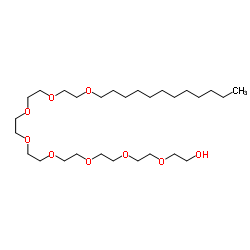Dodecyl octaethylene glycol ether

Dodecyl octaethylene glycol ether structure
|
Common Name | Dodecyl octaethylene glycol ether | ||
|---|---|---|---|---|
| CAS Number | 3055-98-9 | Molecular Weight | 538.755 | |
| Density | 1.0±0.1 g/cm3 | Boiling Point | 585.5±45.0 °C at 760 mmHg | |
| Molecular Formula | C28H58O9 | Melting Point | 30ºC | |
| MSDS | Chinese USA | Flash Point | 307.9±28.7 °C | |
|
Folding and Intramembraneous BRICHOS Binding of the Prosurfactant Protein C Transmembrane Segment.
J. Biol. Chem. 290 , 17628-41, (2015) Surfactant protein C (SP-C) is a novel amyloid protein found in the lung tissue of patients suffering from interstitial lung disease (ILD) due to mutations in the gene of the precursor protein pro-SP-C. SP-C is a small α-helical hydrophobic protein with an un... |
|
|
Molecular and biochemical characterisation of human short-chain dehydrogenase/reductase member 3 (DHRS3)
Chem. Biol. Interact. 234 , 178-87, (2015) • DHRS3 is an integral membrane protein with its C-terminus in the cytosol. • Androstenedione and estrone are substrates of DHRS3 in vitro. • DHRS3 was inserted into proteoliposomes. • Expression of DHRS3 protein was detected in the human liver, testes and sm... |
|
|
Octadecyl ferulate behavior in 1,2-Dioleoylphosphocholine liposomes.
Spectrochim. Acta. A. Mol. Biomol. Spectrosc. 153 , 333-43, (2015) Octadecyl ferulate was prepared using solid acid catalyst, monitored using Supercritical Fluid Chromatography and purified to a 42% yield. Differential scanning calorimetry measurements determined octadecyl ferulate to have melting/solidification phase transi... |
|
|
Selective inhibitory effects of hybrid liposomes on the growth of HIV type 1-infected cells in vitro.
Bioorg. Med. Chem. Lett. 18 , 4578-80, (2008) A good correlation between fifty-percent inhibitory concentration (IC(50)) of hybrid liposomes (HL) composed of dimyristoylphosphatidylcholine and polyoxyethylene(n) dodecyl ether on the growth of MOLT-4/IIIB cells (MOLT-4 cells chronically infected with huma... |
|
|
N-glycosylation and topology of the human SLC26 family of anion transport membrane proteins.
Am. J. Physiol. Cell Physiol. 306(10) , C943-60, (2014) The human solute carrier (SLC26) family of anion transporters consists of 10 members (SLCA1-11, SLCA10 being a pseudogene) that encode membrane proteins containing ~12 transmembrane (TM) segments with putative N-glycosylation sites (-NXS/T-) in extracellular ... |
|
|
Interaction of Plasmodium vivax Tryptophan-rich Antigen PvTRAg38 with Band 3 on Human Erythrocyte Surface Facilitates Parasite Growth.
J. Biol. Chem. 290 , 20257-72, (2015) Plasmodium tryptophan-rich proteins are involved in host-parasite interaction and thus potential drug/vaccine targets. Recently, we have described several P. vivax tryptophan-rich antigens (PvTRAgs), including merozoite expressed PvTRAg38, from this noncultiv... |
|
|
Manipulation of activity and orientation of membrane-reconstituted di-tripeptide transport protein DtpT of Lactococcus lactis.
Mol. Membr. Biol. 16(4) , 297-304, (1999) The di-tripeptide transport system (DtpT) of Lactococcus lactis was purified to apparent homogeneity by pre-extraction of crude membrane vesicles with octaethylene glycol monodecyl ether (C10E8), followed by solubilization with n-dodecyl-beta-D-maltoside (DDM... |
|
|
Colloidal bismuth subcitrate impedes proton entry into Helicobacter pylori and increases the efficacy of growth-dependent antibiotics.
Aliment. Pharmacol. Ther. 42 , 922-33, (2015) Successful eradication of Helicobacter pylori is becoming more difficult, mainly due to emerging antibiotic resistance. Treatment regimens containing bismuth have increased efficacy, but the mechanism is unknown. Helicobacter pylori is a neutralophile adapted... |
|
|
Characterization of mixed non-ionic surfactants n-octyl-β-D-thioglucoside and octaethylene-glycol monododecyl ether: micellization and microstructure.
J. Colloid. Interface Sci. 361(1) , 178-85, (2011) Mixed micelles of n-octyl-β-D-thioglucoside (OTG) and octaethylene-glycol monododecyl ether (C(12)E(8)), two non-ionic surfactants belonging to the alkyl glucosides and polyoxyethylene alkyl ether families, respectively, were investigated by using light scatt... |
|
|
Bis-quaternary gemini surfactants as components of nonviral gene delivery systems: a comprehensive study from physicochemical properties to membrane interactions.
Int. J. Pharm. 474(1-2) , 57-69, (2014) Gemini surfactants have been successfully used as components of gene delivery systems. In the present work, a family of gemini surfactants, represented by the general structure [CmH2m+1(CH3)2N(+)(CH2)sN(+)(CH3)2CmH2m+1]2Br(-), or simply m-s-m, was used to pre... |